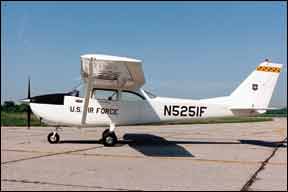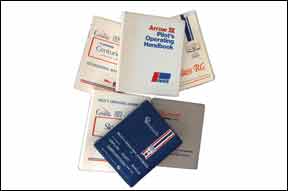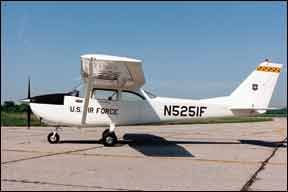Fishpot Turner!” yelled the voice at the front of the small classroom. Clad in an olive-drab U.S. Air Force flight suit, I sprang to attention from my chair behind a small table. I was one of about 20 pre-solo students in the USAF’s Flight Screening Program—Officer Training: FSPOT, pronounced “fishpot.” We were undergoing initial pilot qualification prior to commissioning as officers in the U.S. Air Force. Our aircraft was the T-41A Mescalero, off-the-shelf 1965 and 1967 model Cessna 172s in stars-and-bars paint flying out of Hondo, Texas.

288
“Engine failure in cruise flight!” barked the flight leader. My job was to announce my way through the scenario from first indications to conclusion, loudly, to the entire group of cadets and our civilian instructors. Hesitate or miss a checklist step and I would be stricken from the flight schedule that day. I don’t recall the criterion, but I bet if that had happened more than once (it didn’t), I would have washed out of the pilot training program.
“Maintain control of the aircraft,” I began. “Glide speed — ESTABLISH. Carburetor heat — ON. Fuel selector — ON. Mixture — FULL RICH. Primer — IN AND LOCKED. Magneto switch — BOTH. Refer to checklist.”
The steps I’d recited to that point appeared in our Air Force “Dash 1” manual for the T-41 as bold-printed items on the Engine Failure in Flight checklist. In Air Force parlance, the bold print items were those that needed to be done from memory, because typically there would not be time to look them up (or even read them from a placard) if we needed the procedure “for real” in the airplane. By using bold print, the Dash 1 made a clear distinction between these “memory items” and less-time-critical actions on the checklists. In fact, in FSPOT we were not permitted to perform the normal-font checklist steps from memory. We were required to look them up on the printed checklist. Hence my call of “Refer to Checklist” at the end of the first round on this scenario.
But I wasn’t done. My Air Force T-41A checklist, on laminated 5×7 cards on a ring so I could Velcro it to my thigh in the airplane, lay on the table before me. Continuing the scenario, I quickly opened to the Engine Failure in Flight checklist and read, step by step, the remaining items. So far, so good. But I wasn’t done yet. It was time for more memory items.
“Glide checklist,” I announced. “Maintain control of the aircraft. Glide speed — MAINTAIN. Trim — SET. Flaps — UP. Radio — CALL MAYDAY. Refer to checklist.” I flipped the checklist card to the Glide procedure and read the remaining steps. The scenario continued. “Landing without power checklist. Landing without power speed — ESTABLISH. Trim — SET. Flaps — AS REQUIRED. Slip — AS REQUIRED. Seat belts and shoulder harnesses — CONFIRM TIGHT. Doors — UNLATCH. Mixture — IDLE CUTOFF. Fuel selector — OFF. Magneto switch — OFF. Battery and generator/alternator — OFF. Touch down on the main gear at the slowest safe speed. After landing: Brakes — MAXIMUM. Flaps — UP.”
There was more: “Emergency cabin egress checklist. Maintain control of the aircraft. Passenger restraints — REMOVE. Aircraft — EVACUATE. Move at least 100 feet from the aircraft. Refer to checklist.
Okay, I may have missed a step or two looking back over nearly 30 years from that stand-up preflight briefing at Air Force Officer Training School. But it was drilled into me enough that I bet I got close. The lesson I learned from “stand-up” was to know beforehand what I needed to do right away, from memory, if an emergency occurred in the airplane. I didn’t end up going on to jet training, the “needs of the Air Force” taking me into intercontinental missile operations (an extremely checklist-intensive environment). But being a FSPOT was a great and, for a general aviation pilot, very unusual introduction to the right way to approach emergency procedures training.
Critical vs. Merely Important
The idea of differentiating bold print from other emergency checklist items teaches the concept that although all your tasks when faced with an in-flight systems failure are important, only a few of your actions are critical. You must be ready to accomplish the few critical steps, right away, to survive the failure. Anything else, including other Emergency Procedures checklist steps, can and should wait until you’re certain you’ve taken care of all the priority items. Take a look at the Engine Failure in Flight checklist for the Cessna 172S Skyhawk, reproduced above as Figure 1.
The list looks pretty close to what I remember from that T-41A so long ago. Which of these steps are critical, memory, “bold print” items? Unlike most light plane manufacturers (and perhaps because of its T-41 experience), Cessna actually does publish the critical emergency checklist steps in bold print in its modern Pilot’s Operating Handbooks (POHs). In the case of the Engine Failure During Flight checklist, steps 1 through 5 are listed in bold print in the C172S POH. Memorize and perform those steps and you’ll get a restart, if the engine is capable of it. If the engine is not running after setting the mixture to full rich, you have more time to make sure you hadn’t bumped the ignition switch off. Turning the boost pump off at the end of the checklist is really part of setting up for a possible off-airport landing if the engine restart didn’t occur.
Consider another Cessna 172S emergency checklist. It’s also reproduced, as Figure 2, on the previous page. As you read the steps, think about which of them are critical to survival. Then decide which steps you would put in bold print if Cessna had not done it for us. The Cessna handbook prints steps 1 through 4 in bold font. They are the most important steps to your survival.
Let’s try one more from the C172S handbook (see Figure 3, also on the previous page). Which steps on this checklist are the bold print items? Trick question: None of the items on this checklist appear in bold print in the Cessna handbook.
What’s this tell us? If faced with an abnormal but not emergency situation like landing on a flat tire, you have time to pull out the printed checklist and review the “emergency” checklist before executing the procedure. Put another way, you don’t need to be in a hurry. You have time to calmly refresh yourself on the best technique before you commit to any action.

288
Common-Sense Memory Items
Often there are important actions that aren’t on the emergency procedures checklists. Airplane manufacturers can’t anticipate every possible emergency scenario. And many vital pilot actions may be considered “common sense” items. Take, for instance, the first step I recited in each of the bold print checklists in my FSPOT stand-up briefing:
“Maintain control of the aircraft.” Most pilots (and all manufacturers) apparently appear to feel this goes without saying. Yet, my experience as an instructor pilot and the general aviation mishap record suggest we could all use some reinforcement of this priority at the beginning of every checklist step—emergency and normal procedures alike.
What might be some other common-sense items that don’t appear on your emergency checklists? How about briefing passengers? Tightening seatbelts and assuring shoulder harnesses are tight? Contacting ATC and/or broadcasting your intentions in the blind on 121.5? Securing loose objects? Engaging backup systems?
Non-Systems Emergencies
Now let’s talk about the POH Emergency Procedures section’s Table of Contents for another popular general aviation airplane, in this case the Beechcraft F33A Bonanza, which is reproduced at left. Take a close look at the emergencies presented in the Handbook. What do you notice?
If you think about it, you’ll realize that, with very few exceptions, POH Emergency Procedures checklists address only airplane systems-related malfunctions and failures. Situations like thunderstorm encounters, airframe icing, bird strikes, partial-panel flight or inadvertent visual flight into instrument conditions generally aren’t covered in emergency checklists (although Cessna does include some of these scenarios in its POHs). That’s understandable—the data and checklists are systems-intensive because that’s what the manufacturer knows and has some control over (at least for anticipating necessary pilot actions). As I said before, the manufacturer can’t anticipate everything. But where does that leave you as a pilot?
Come up with your own checklists for issues that you might encounter. Then use the concept of bold print items to determine which steps on your personal checklists are time-critical to your survival…so you know what you need to memorize for each of those emergency scenarios.
Missing Checklists
Sometimes there are potentially dangerous systems-related situations that for whatever reason are not reflected in an Emergency Procedures checklist. Looking again at the Bonanza example, you may have noticed there is no Electrical Fire or Overheat procedure in the POH. Yet I imagine there are some time-critical, bold-print steps to perform if smoke begins pouring from a radio stack or circuit breaker panel, for instance:
1. Maintain control of the aircraft
2. Battery and Alternator Switches – OFF
3. Cabin – VENTILATE
From there I (or you) can list further actions that permit the use of a printed emergency checklist, steps like turning individual avionics and electrical equipment off, using a fire extinguisher if necessary, allowing time for the overheating equipment to cool and turning back on only those minimum necessary items to make a landing at the closest suitable airport (unless the fire does not go out, which calls for an Emergency Descent and landing on whatever’s beneath you at the time).
Again, it’s up to you to develop your own checklists, considered from the calm of your office or easy chair and printed for cockpit use, and then identifying any bold print items you need to memorize.
Memorizing and Practicing
Knowing that the bold print checklist items exist is only the beginning. The goal is to be able to accomplish those steps, almost without thinking, under the stress of an actual aircraft emergency. You don’t need to bark out emergency procedures to your pilot buddies and make them stand up and recite the checklist back to you (although that’s a real good activity for a fly-in, a flying club meeting or a Civil Air Patrol gathering). But you do need to feel ready to be on the receiving end of the stand-up challenge. If you think being tasked to remember emergency checklist steps in front of your peers is too stressful or too uncomfortable, then you really aren’t ready for the stress of performing when your life truly depends upon it.
How can you gain this level of familiarity with the bold print of your airplane’s checklists? Here’s how we did it in the “fishpot” program:
• Read, read, read…spend lots of quality time on rote memorization, just like cramming for a college exam.
• Study the Systems Description, Limitations and Normal Procedures sections of the Pilot’s Operating Handbook (or in the Air Force, the Dash 1). This gives you deep systems knowledge and insight that turns rote memorization into understanding, so you know the “why” of bold print checklist steps.
• Make flashcards (or their electronic equivalent). Write an emergency situation (“Engine Failure in Flight,” “Electrical Failure,” etc.) on one side of a card, and the bold print checklist steps on the back of the card.
• Actually use the flashcards. Keep a stack of them handy—in your car or in your office. Every time you have a few idle moments, randomly pull a card from the stack, read the situation and say the bold print checklist steps out loud. Check the back of the card to grade yourself and refresh your memory.
• Use your personal Flight Training Device—the airplane. Sit in the cockpit while holding the controls, then randomly pull an emergency situation card and actually move switches and controls as you would when accomplishing the bold print steps. Be careful to avoid doing anything that might damage the aircraft (for example, retracting landing gear in the hangar). When you’re done, use the Normal Procedures After Landing, Shutdown and Securing Landing checklists to put everything in its proper place for the next flight.
A Final Check
Outside of primary or initial multi-engine training, general aviation pilots commonly aren’t exposed to military- and airline-style emergency procedures. This leaves many pilots ill-prepared to respond swiftly, decisively and properly in the unlikely event of an in-flight emergency. With a little study and some creative practice, however, you can develop an enhanced level of emergency preparedness by knowing the bold print steps of emergency procedures checklists that are in the Pilot’s Operating Handbook, and those you create as custom checklists for your airplane and operation.




